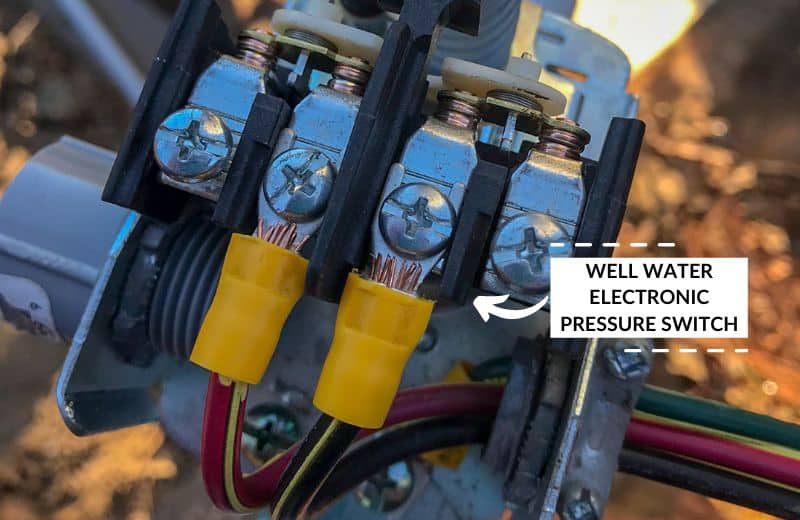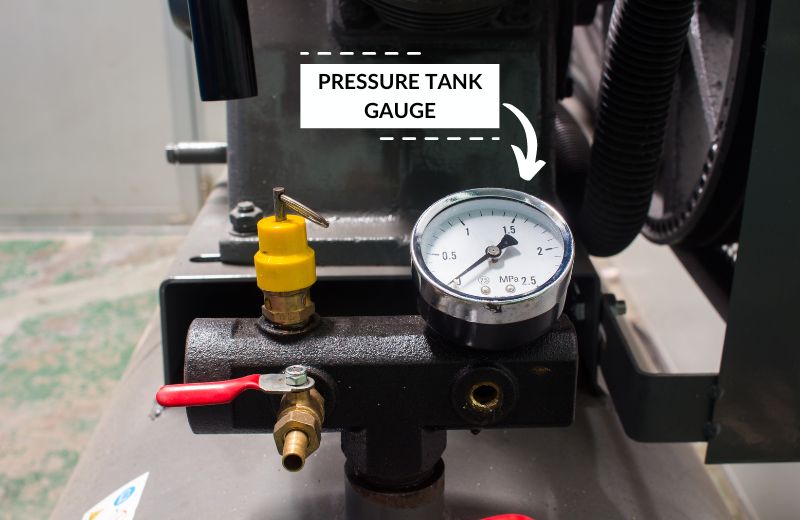Wondering how to adjust the pressure switch for your well pump and pressure tank? We’ve shared the step-by-step process in this guide.
📌 Key Takeaways:
- A well pump pressure switch is a switch that automatically controls when the well pump will switch on (the cut-on pressure) and when it will cut out (the cut-out pressure).
- You might need to occasionally adjust the pressure switch to increase pressure or lower pressure based on your water demands.
- To adjust a well pump pressure switch, switch off your well pump’s power, then remove the cover of the switch and turn the nut on the big spring to raise or lower the pressure.
Table of Contents
📋 How to Adjust A Well Pump Pressure Switch: Step-By-Step
You don’t need to be an expert to adjust the pressure switch for your well water pump, and nor do you need to call a well contractor to do it for you.
Follow these steps:
- Shut off the well pump’s power. To make sure you stay safe when working with the pump’s electrical components, switch off the power to the pump before you get started.
- Remove the pump cover. Take the cover off the pump. You might need a screwdriver for this, depending on how the cover is installed.
- Turn the large spring. Beneath the pump cover, you should see a large spring and a smaller spring. Both have a nut on top. Locate the large spring and turn the nut clockwise to raise both the cut-in pressure and the cut-out pressure. To lower the cut-in point and the cut-out point, turn the nut counterclockwise. Rotating the nut once should adjust the cut-in and cut-off pressures by 2-3 PSI.
- Adjust the tank’s air charge. The air charge in your pressure tank will also need to be adjusted in your tank. Make sure the cut-in pressure is 2 PSI higher than the pressure tank’s air charge.
- Replace the pump cover. Never leave live electrical contacts exposed. Once you’ve adjusted the cut-in and cut-out pressures to your liking, replace the pump cover before switching on the power to the pump.
To check whether your well water pump pressure adjustment has been successful, keep an eye on your well tank’s pressure gauge. This will tell you exactly when the pump turns on and off. Note that it might take a few pump cycles before you see the effect of your adjustment.
There are a few occasions when you might need the help of a professional.
For instance, if your cut-in or cut-off pressure drops after adjusting, you can’t get your pressure readings right, or you have an air pressure issue in the tank that you can’t fix, you might have a problem that needs to be addressed by a well contractor.

🤔 How To Adjust a Square D Pressure Switch
This section of the guide comes with a word of warning: you should never adjust your square D pressure switch (the smaller nut that’s just for the cut-off pressure) unless you’re a plumbing expert or you’ve been advised on what to do by a professional.
Adjusting this spring is virtually the same as adjusting the larger spring:
- Shut off the well pump’s power. This will prevent the risk of electric shocks while you’re working.
- Remove the pump cover. You might need to unscrew the cover with a screwdriver.
- Turn the small spring. Locate the square D spring (the smaller of the two springs) and turn the smaller nut in a clockwise direction to raise the cut out setting pressure. Or, turn the nut counter-clockwise to lower the cut-off pressures.
- Replace the pump cover. Once you’re happy with the changes you’ve made, replace the pump cover and switch the power back on.
It’s especially important to make sure you adjust the square D spring properly. Improper adjustments could result in a continuously running well pump, which will quickly burn the motor and shorten the pump’s lifespan.
📈 Common Pressure Settings & Their Differences
There are two common settings for well pressure switches:
- 30/50
- 40/60
The number before the slash is the low pressure that causes the pump to switch on, and the number after the slash is the high pressure that triggers the pump to cut out.
The amount of water pressure received by your home’s pipes, faucets, and other fixtures and appliances is directly affected by the pressure tank’s settings.
40/60 switches are ideal for large homes with multiple floors and lots of water-using appliances, while a 30/50 switch is better suited for smaller households with reduced water use. You can use any type of switch regardless of the pump type you have (a submersible pump, a jet pump, a reciprocating pump, etc.).
If you have old plumbing, it’s best to use a 30/50 switch to prevent damage to the plumbing caused by high water pressure.

⚙️ Ideal Pressure Setting For Well Pressure Switches
So, what’s the ideal pressure for your well’s pressure switch?
This depends on a few factors, including your pressure tank capacity and your water demands.
There’s an easy way to find out your ideal well pressure switch setting: remove the cover of the switch and read the back. There should be a factory setting for your pressure switch with the recommended settings.
However, the size of your home and your water usage may mean that you require a different pressure setting.
You’ll be fine with a low pressure setting if you have a small home or you don’t want high water pressure in your home. The lowest settings for a pressure system are 20/40, or 20 PSI for your pump to cut in, and 40 PSI for your pump to shut off.
On the other hand, if you use a lot of water or have a big home with water-using appliances on several floors, your pressure settings should be higher. For a high-pressure system, the standard is 40/60, or 40 PSI for your pump to cut in, and 60 PSI for the pump to shut off.
There are a few other factors worth considering:
- The number of people in your home
- How many appliances you have
- The age of your home’s water piping
Don’t deliberately adjust your pressure setting as low as possible with the aim of saving money by reducing pressure in your water system. If you need a higher pressure setting than you configure, you’ll significantly reduce the efficiency of your fixtures and water-using appliances. Many appliances need a minimum water pressure to operate.
🔁 How To Reset A Well Pressure Switch
Need to reset your well pressure switch? This is a quick job that takes only a few minutes – no tools required.
Here’s what you need to do:
- Shut off your appliances. Before you start, shut off all the appliances in your home that use water, including washing machines, dishwashers, and refrigerators with automatic ice makers.
- Find the pressure switch. It’s usually located on the pipe that connects to the tank in a small gray box.
- Locate the reset lever. This is typically on the side of the switch. Check your user manual if you’re unsure.
- Reset the switch. Maneuver the lever to reset the switch. Depending on the lever design, you’ll probably need to move the lever to “Start” until you can hear the flow of water, then hold the lever until the pressure gauge reading hits the pump cut-in pressure (usually 30, or 40 PSI).
- Leave the pump to run. Allow the lever to move back to its original position and wait for the pump to draw water into the pressure tank until the cut-off pressure is reached (usually 50, or 60 PSI).

❔ Well Pressure Switch Adjustment: FAQ
Can I adjust a pressure switch?
Yes, most well switches can be adjusted from their factory presets. So, you could adjust a 30/50 switch to a 40/60 switch if you needed to. Just make sure the pump in your well could withstand the pressure first. For instance, your pump might only tolerate a maximum pressure of 50 PSI, meaning that you couldn’t use it with a switch set to 40/60.
What should my well pressure switch be set at?
There are many variables that affect what your well switch should be set at, including your pump’s maximum pressure tolerance and your house size and water usage. Smaller homes generally need a 30/50 switch, while larger homes with multiple floors need a 40/60 switch.
How do I know if my well pressure switch is bad?
Signs your well pressure switch is bad include a continuously running pump (even when the cut-off pressure is achieved), a pump that doesn’t switch on when the lower water pressure figure is reached, a pump that cycles on and off randomly, low water pressure in your home, and problems with the water flow in your fixtures (such as a toilet that won’t flush). However, these signs are signs of numerous other problems, including a bad connection in the tube or an issue with the controller, so don’t reset the switch until you’ve fully assessed the situation.
